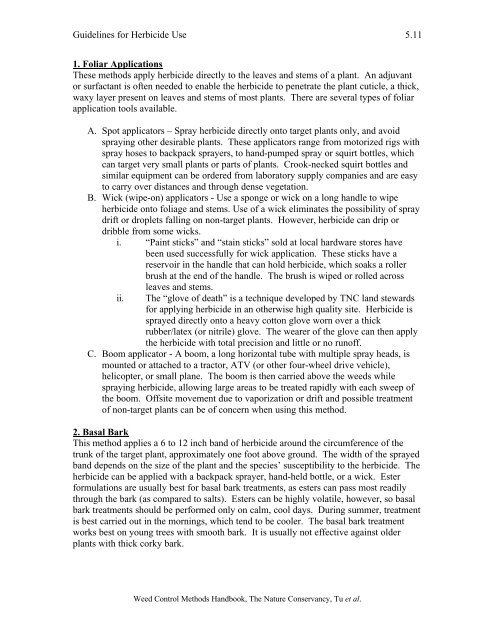Weed Control Methods Handbook: Tools ... - Invasive.org
Weed Control Methods Handbook: Tools ... - Invasive.org
Weed Control Methods Handbook: Tools ... - Invasive.org
You also want an ePaper? Increase the reach of your titles
YUMPU automatically turns print PDFs into web optimized ePapers that Google loves.
Guidelines for Herbicide Use 5.11<br />
1. Foliar Applications<br />
These methods apply herbicide directly to the leaves and stems of a plant. An adjuvant<br />
or surfactant is often needed to enable the herbicide to penetrate the plant cuticle, a thick,<br />
waxy layer present on leaves and stems of most plants. There are several types of foliar<br />
application tools available.<br />
A. Spot applicators – Spray herbicide directly onto target plants only, and avoid<br />
spraying other desirable plants. These applicators range from motorized rigs with<br />
spray hoses to backpack sprayers, to hand-pumped spray or squirt bottles, which<br />
can target very small plants or parts of plants. Crook-necked squirt bottles and<br />
similar equipment can be ordered from laboratory supply companies and are easy<br />
to carry over distances and through dense vegetation.<br />
B. Wick (wipe-on) applicators - Use a sponge or wick on a long handle to wipe<br />
herbicide onto foliage and stems. Use of a wick eliminates the possibility of spray<br />
drift or droplets falling on non-target plants. However, herbicide can drip or<br />
dribble from some wicks.<br />
i. “Paint sticks” and “stain sticks” sold at local hardware stores have<br />
been used successfully for wick application. These sticks have a<br />
reservoir in the handle that can hold herbicide, which soaks a roller<br />
brush at the end of the handle. The brush is wiped or rolled across<br />
leaves and stems.<br />
ii.<br />
The “glove of death” is a technique developed by TNC land stewards<br />
for applying herbicide in an otherwise high quality site. Herbicide is<br />
sprayed directly onto a heavy cotton glove worn over a thick<br />
rubber/latex (or nitrile) glove. The wearer of the glove can then apply<br />
the herbicide with total precision and little or no runoff.<br />
C. Boom applicator - A boom, a long horizontal tube with multiple spray heads, is<br />
mounted or attached to a tractor, ATV (or other four-wheel drive vehicle),<br />
helicopter, or small plane. The boom is then carried above the weeds while<br />
spraying herbicide, allowing large areas to be treated rapidly with each sweep of<br />
the boom. Offsite movement due to vaporization or drift and possible treatment<br />
of non-target plants can be of concern when using this method.<br />
2. Basal Bark<br />
This method applies a 6 to 12 inch band of herbicide around the circumference of the<br />
trunk of the target plant, approximately one foot above ground. The width of the sprayed<br />
band depends on the size of the plant and the species’ susceptibility to the herbicide. The<br />
herbicide can be applied with a backpack sprayer, hand-held bottle, or a wick. Ester<br />
formulations are usually best for basal bark treatments, as esters can pass most readily<br />
through the bark (as compared to salts). Esters can be highly volatile, however, so basal<br />
bark treatments should be performed only on calm, cool days. During summer, treatment<br />
is best carried out in the mornings, which tend to be cooler. The basal bark treatment<br />
works best on young trees with smooth bark. It is usually not effective against older<br />
plants with thick corky bark.<br />
<strong>Weed</strong> <strong>Control</strong> <strong>Methods</strong> <strong>Handbook</strong>, The Nature Conservancy, Tu et al.
















